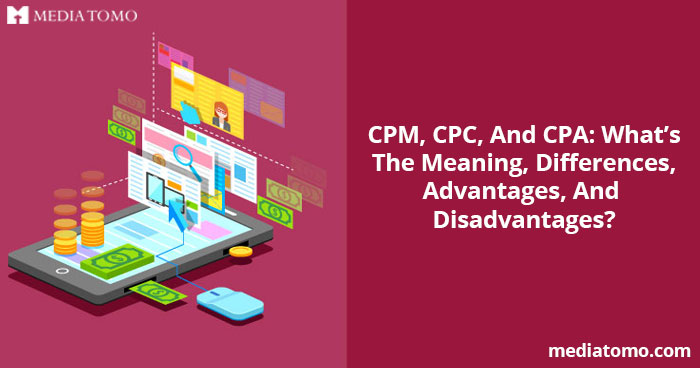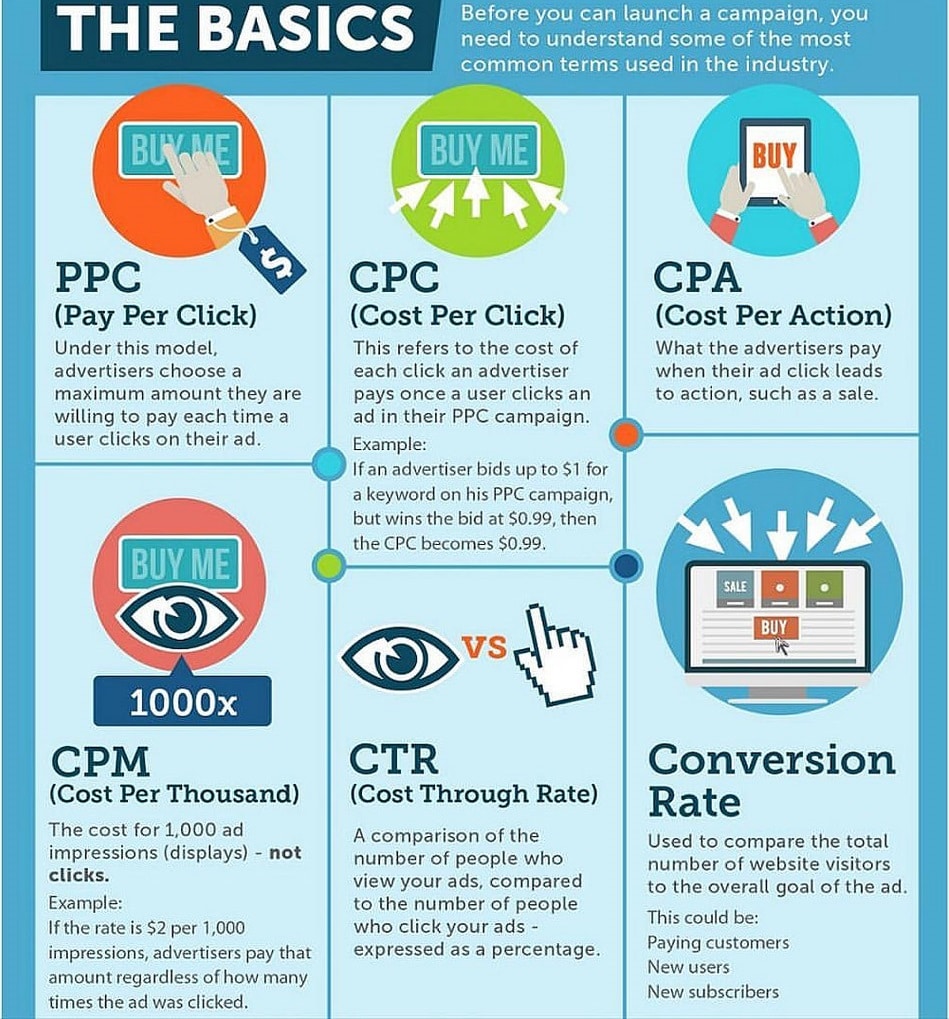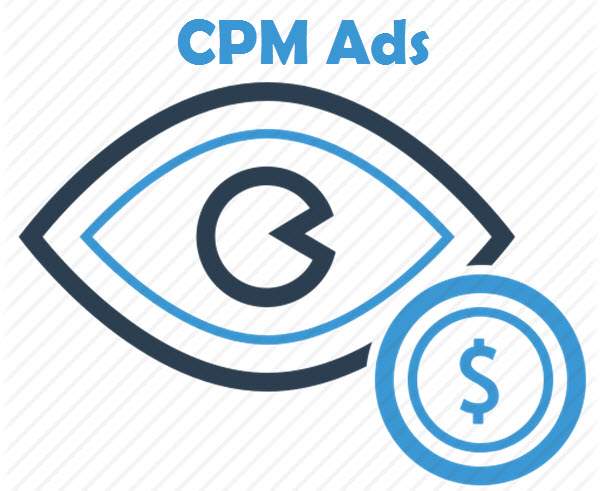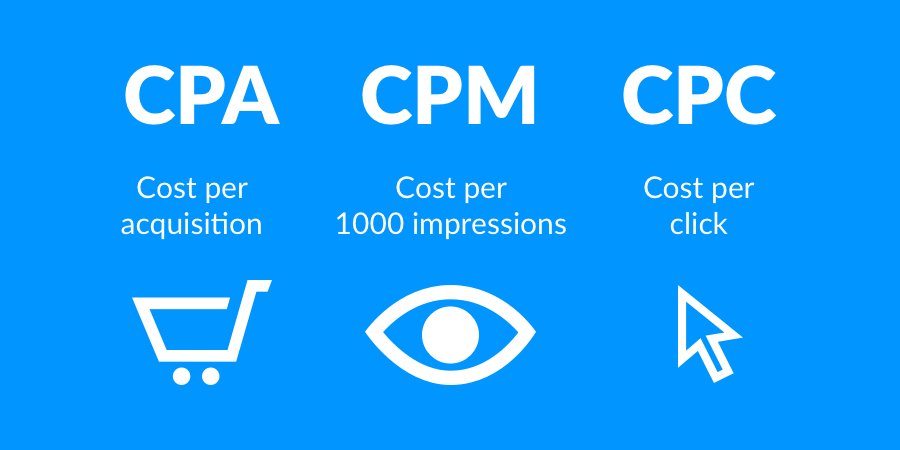
Online advertisement is on its peak, everyone wants to grow and expand their business. And the use of this can only be done with the help of paid advertisements. The more you advertise for your product there are more chances of generating more revenue for your business. But there are certain measures to calculate the cost for every metric but they are quite confusing. So because of this, we are going to understand the meaning, difference, advantages, and disadvantages of CPM, CPC, and CPA.

Before dwelling deep in all these metric we should understand “How all these metrics are interrelated to each other?”
In brief- CPM, CPC, and CPA are all the metric which are used in the advertisement to ascertain the cost. Wherein CPM is used when an advertiser publishes its ad for wants more publicity for its product and wants to pay less. Whereas CPC is used when the advertiser wants both publicity and wants more sales. And in this list CPA is the most expensive but the most effective way to acquire quality leads. Know after understanding all this we can say that these are all the different walls of a house on which advertisement is planned.
What is CPM (Click per Mile)?
CPM (Cost per mile) can also be used interchangeably as Cost per Thousand which depicts the actual meaning of CPM. As it can be easily understood by anyone by the word that it has some relations with thousand that can be further understood in this post.
In this advertising model, the cost of an ad charged is per 1,000 impressions (or displays) by companies to advertisers. But wait! What does this impression mean? An impression is a term that is specially used to denote how many times your ad is served in front of your readers.

Wherein CPM is a marketing term that denotes the price of 1,000 advertisement impressions on a single webpage. If a website publisher charges, let’s say, $2.00 CPM, this can be interpreted in a way that an advertiser must pay $2.00 for every 1,000 impressions or views of its ad on the particular website.
Quite frequently, advertisers measure the success of a CPM campaign with the help of the click-through rate. The click-through rate is the percentage of people who have viewed your ads on web pages and also clicked on them. Thus, an advertisement that receives two clicks for every 100 impressions will have a 2% CTR (click-through rate).
However, you cannot measure an advertisement’s success solely by its CTR for the reason being that an audience views the ad but does not click on it, which may have an impact on generating revenue.
Advantages and disadvantages of CPM for the Advertiser
There are multiple advantages and disadvantages of CPM when used by the advertiser which are discussed under-
Advantages-
- One of the positive sides of this model is that this model is cheap in comparison to others.
- This model is useful for increasing brand awareness among the new and potential customers and promotion via this model is very effective because of its cheap pricing.
- One more advantage of this model is that this model guarantees to deliver a fixed number of impressions to your target audience.
Disadvantages–
- The biggest disadvantage of using the CPM model is that it cannot be ascertained that the impressions are worthy or not, i.e are the impressions shown are on high traffic websites are having quality traffic.
- One more disadvantage is that there is a high-risk of fraud impression or it can be like that your ad may be shown multiple times to the same person and you can be billed for the same.
- The major disadvantage of this is that it does not show or indicate the action takers or who are clicking on the particular ad.
Having multiple advantages for the advertiser this format is also having more disadvantages for the advertiser. So it must be ascertained is this model is helping to achieve the desired target or not. As in one way if it is good for promotion than in the other way it is worst as you can not ascertain the action takers from this method.
Advantages and disadvantages of CPM for the publisher
There are multiple advantages and disadvantages for the publisher when using CPM for their monetization purpose through ads-
Advantages-
- When the publishers are using ads for their website monetization purpose CPM is the best model, if the website is a good source of traffic. As when you are having a ton of traffic from multiple sources than it is worth for monetization as it only counts the impressions.
- One of the prime advantages of CPM is that it is the permanent stream of income as this does not require any type of hustle for clicks. Because of which it is very much predictable that how much you will get.
- The viewership of impressions is verifiable and can be expressed in quantity so there is no chance of fraudulent.
- CTR is a great metric from the point of publishers as it depicts the rate at which the customers are being generated. With the help of an ad model which leads to less revenue because of fewer ad clicks but in CTM there’s no issue for this as the money you are receiving is only for the impressions.
Disadvantages-
- The major disadvantage of this model is that the anticipated revenue is less than the revenue which someone will get in CPC and CPA model.
- Another disadvantage in this model is that it requires very high traffic for more generations of revenue as they both are equally dependent on each other.
- For having a successful advertising program the publisher requires much expertise and time.
- There may be a chance that you are less paid because of the CPM model as your website can give more clicks and can generate more revenue with the CTC model.
What is CPC?
CPC (Cost per click) is one of the most privileged and prominent formats of digital advertisement. In this format, the advertiser needs to pay the publisher every time his ad view gots a click. It is also known as Pay Per Click (PPC). CPC is mostly used as and when your product has a handsome amount of popularity in your target market.
In this model advertisers usually set their daily budget according to their potential and market. But as and when the budget hits its potential the ads are removed with a remainder of the billing notification. Here is an exact example that tells how this procedure rolls down-

For instance, a website that has a CPC rate of 10 cents and offers 1,000 click-throughs will bill $100 ($0.10 x 1,000). The amount that an advertiser pays for a click may be set through a bidding process. To calculate Cost per Click (CPC), the formula used is Cost per Impression (CPI) divided by percent Click-through Ratio (that is, %CTR).
Since a large number of businesses are done online and advertising is increasing rapidly, publishers usually look for third-parties in order to match them with advertisers – in this case, Google AdWords can be set as an example.
Advantages and disadvantages of CPC for the advertiser
Everything is accredited with some type of advantages and disadvantages here in CPC the same situation happens for the advertiser. Let’s dwell in its core advantages and disadvantages-
Advantages-
- One of the advantages of using this ad format is that the product receives more exposure even after not paying for it.
- When you are running CPC format ads then it gives high-quality traffic to your website.
- The main and foremost advantage of this budget is that your ads are limited to your budget
- The ad helps in receiving quality leads as if someone has clicked on your ads then there might be some intention of purchasing the same.
Disadvantages-
- It requires a huge budget as it is very much expensive and includes cost as and when the advertiser wants to run their ads.
- There can be possibilities of fake clicks as more clicks give a new way for a good income source.
Advantages and disadvantages of CPC for the publisher
Advantages
- CPC is the more lucrative form of advertisement as this format is more appealing to the targeted customers. It requires more attention as there is a medium risk in this. As in this model, the publisher is only paid after when a visitor clicks on the ad being displayed.
- There is more advantage while publishing this format ad as the ROI(Return on Investment) is more measurable.
- This format is useful for publishers as it attracts more advertisers.
- While publishing these types of ads one more advantage for publishers is that they can collect more data with CPC to use in selling ads.
Disadvantages-
- This format is not a good source of income if your website is having a ton of traffic from all parts of the world as you can shift to another one i.e CPM(Cost per Mile).
- This format is not a guaranteed source of income as the income gets generated after an ad is clicked on your website. And the revenue is less as compared to CPM.
- This format has a drawback as it decreases traffic from your website to someones else website.
- For this format, it requires a high click-through rate on the publisher’s websites.
What is CPA?
CPA(Cost per Action) is the most effective and advanced way for the generation of sales and leads. As this is the safest way for the advertisers in comparison to other techniques. This format of advertisement is suitable when your product has achieved popularity among its potential users
In this advertising model, publishers only receive payment only when the visitors or the impression gets converted into leads i.e when they had filled all the useful data which are required for further contacts.

For example, when any online visitors intentionally gets convinced by your ad and fill up your subscription list after filling his data than the advertiser must pay the amount for the action being taken. And if we are moving on the numerical example this is like this-
Suppose you receive four conversions on the ad being displayed on the publisher’s website. And the pricing format maybe- $4, $6 respectively, So for this ad pattern your average CPA for these conversions is $5 for each. Here the thing is that your average CPA might be different from your target CPA because it is the result of your actual CPA average.
Each time a user achieves this type of action, the advertiser pays the agreed rate. Thus, when a company charges an advertiser using a CPA model, the advertiser only pays out if a user clicks and does a specific action, like purchasing a product or service via the ad conversion.
Advantages and disadvantages of CPA for the advertiser
Advantages-
- This format of advertisement is very much useful for those advertisers who have a well-developed market for its product.
- There is no payment done if it shows no results, so we can say that this format is more cost-effective as the payment is done for the action takers.
- This format is also helpful for advertisers who have developed market and want to generate sales and revenue as this format is very much helpful in the generation of more sales leads.
- In one more way, this format is helpful as this format of the ad receives even without any clicks.
- Here in this format, there is no type of risk and responsibility on the shoulders of the advertiser. As it is the responsibility of the publisher to curate those types of content that is more appealing to its audience for generating quality traffic. The reason behind this is that this traffic has the potential to become leads for someone.
Disadvantages-
- The major disadvantage of this format is that this format of advertisement is very much expensive in comparison to other formats.
- This is the only format which is having the lowest rate of conversions as the success of this format is only calculated after the action has been taken.
Advantages and disadvantages of CPA for the publisher
Advantages-
- There are more chances of plowing back more revenue simply by showing CPA ads if your website is a good source of quality traffic.
- There are more chances of good conversions if the advertisement shown have a good image in the market.
Disadvantages–
- The major disadvantage of this format is that payment is not made according to their clicks. As the payment requires more action takers.
- No revenue is generated for mere clicks and impressions. So for revenue purposes, this method has a drawback.
Difference between CPM, CPC, and CPA
As we already know that CPM, CPC, and CPA all are the matrics that are closely related and are used for publishing ads on digital platforms. As CPM is effective for brand promotion for the new products, CPC is used for promotion and conversion whereas CPA is only used for collecting leads but then also there is a huge difference among all three.
Where in CPM we have seen that this metric is mainly useful for those brands who are till date, not get that much exposure for which they are required. The main purpose of running CPM ads is that their brands must be known by its potential audience.

Similarly, in CPC we have seen that this metric is useful for those brands who had got much more exposure than as a new brand. This format is helpful for those who want conversions with exposure to be known by their target audience. More importantly, we can say that this format is more used especially for those products which are specific to the niche market.
And if we are talking about Cost Per Action (CPA) this is the most advanced way of advertisement. As in this, we can say that this format is only used by those marketers who are having a well-developed market for their products. This method is more prevalent for those products who want more leads for their business purpose.
Its goal is to have the viewer purchase your product or services because of having an important factor i.e. high click-through rate.
Conclusion
As above we have discussed the advantages and disadvantages of all the three formats of advertisement(CPC, CPM, and CPA) it provides anyone a clear view of which to use at a particular time.
The article provides a clear view to the newbies about which type of advertisement to be run or to be published on their website. And gives a whole view to the marketers to select the actual format which is useful for their business.
The revenue options available to publishers continue to grow, as media and the hardware people use to access it change. A strong advertising sales approach can align your business with the right online ad model.
